
"If you are cold, tea will warm you ~ If you are heated, tea will cool you ~ If you are depressed, tea will cheer you ~ If you are excited, tea will calm you.." ~William Gladstone
Growing up, I had tea every day- for lunch and dinner. Not herbal tea, though. This was Lipton tea, brewed in an aluminum pan, with who knows how much sugar and served from an old, aluminum pitcher-iced. 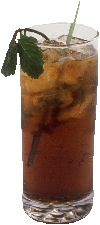 My grandma would get up in the morning, put on the coffee and then proceeded to make the tea so it would be iced and ready by noon when my Grandpa would come in from the garden and my mom would come home for lunch. Sometimes on hot summer days, it would be adorned with a mint sprig or two--which was my first memory of actually tasting herbs. Hot tea, served in proper tea cups was always reserved for illnesses--not herb tea--still Liptons!!--and served with burnt and buttered white bread toast. I loved it and always felt better.
My grandma would get up in the morning, put on the coffee and then proceeded to make the tea so it would be iced and ready by noon when my Grandpa would come in from the garden and my mom would come home for lunch. Sometimes on hot summer days, it would be adorned with a mint sprig or two--which was my first memory of actually tasting herbs. Hot tea, served in proper tea cups was always reserved for illnesses--not herb tea--still Liptons!!--and served with burnt and buttered white bread toast. I loved it and always felt better.
Not until I was 10 and became interested in studying herbs, did we all begin to experiment with daily cups of comfrey, chamomile and mint teas, but that became in ADDITION to the iced tea- not instead of. Except for the doll and teddy bear teas with plastic cups as a child, it was not until years later that I had a formal tea party and even more years that I went to a formal Tea Room. But, I still drink tea of one type or another EVERY day because it changes the pace, allows me to slow down and think or relax, offers several medicinal benefits and creates a space in the day that is special-sacred. Tea time should be a daily occurance- something you make time for at home or at work. No need to be fancy. Tea in a thermos or a mug is just as helpful and relaxing as the occasional party.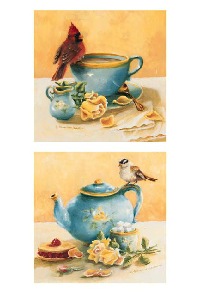
So, read on...learn about tea and then if intriqued, take a look at the tea themed parties for adults and children--not the frilly kind, but good, fun, easy get togethers that combine health with conviviality and offer an enjoyable pathway into herbalism....
"Tea gives one vigour of body, contentment of mind and determination of purpose, when taken over a long period of time" ~ Lu Yu
Lipton's and all black teas come from the plant Camellis sinensis- and are, of course, "herbal teas", though most people make a distinction between them. The difference is that black teas contain caffeine, yet there are many herbal teas that contain it as well--and, Green tea is also from the Camellis plant, but because of how it is processed, has little caffeine and is considered herbal and healthier--at least it was before all the information about the useful antioxidents and several other constituents that make even caffeinated Lipton's good for you. Is this all confusing? Relax! "Experts" label products from the Camellis plant, as "tea". Black, White and Green teas are all the same leaves, simply oxidized and fermented for different lengths of time, which accounts for their differing flavors and constituents. Any drink made from other plants (aka- herbs) is considered an "infusion" or "tisane". To be honest, it is all ridiculous--EVERY plant is an herb, each with its own tastes, properties and medicinal values. Black teas were originally used medicinally for wound healing and digestion--and so highly valued, bricks of dried leaves were used as currency--just as other herbs were-most notably, Mint. It really is just a matter of knowing what qualities you want or need from your tea, and seeking out the proper plant. So, here, the word "tisane" will rarely be used, "infusion" will be reserved for very medicinal concoctions- and TEA will refer to any drink made from any plant--including mushrooms, bark, berries and lichens!
A REALLY BRIEF HISTORY OF TEA
The story goes that around 4000 years ago, in China, the Emperor, Shen Nung had recognized the importance of boiling water before drinking it to avoid diseases. One day as he rested under a bush, with his boiled water sitting nearby, he dozed off and in the meantime, a leaf of the bush, Camellis sinensis, fell into his cup and steeped while he slept. Upon waking and tasting the drink, he felt it was valuable (Other Asian countries have their own versions ). First considered a medicinal beverage for a variety of illnesses, drinking and using the tea became so widespread that ceremonies developed around it and later, it also became a social activity.
So valuable to general wellbeing, Camellis, along with many other plants, became forms of currency. Tea traveled to Japan and then to Europe and England where it was promoted by CharlesII and his wife in the mid-1600's. Boiled or fermented drinks were used by everyone by that time-especially in populated areas. At first, the Chinese style of tea was used, but slowly developed in Europe and by 1840, the Dutchess of Bedford made popular the Afternoon Tea after complaining of the "tired and sinking feeling" she felt every afternoon. By the Victorian era of the late 1880's-all social classes took tea. Herbal teas, of course were more popular amongst peasants and included teas of vegetables/weeds/flowers.
As Tea moved to America, it was the drink of choice-after beer-for all ages--until the Revolutionary War, when tea became associated with the English tyranny and then coffee gained a foothold--but also, a return to herbal teas was seen as well. 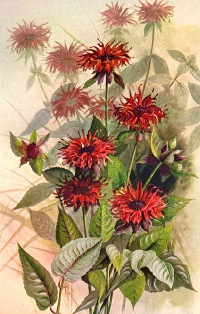 Monarda, also known as OSWEGO TEA and Bee Balm, became a substitute for English tea. It grew (and still does) in the countryside of New England. While tasting much like black tea, it has some of the same and many other medicinal qualities, but was free for all to grow, harvest and drink.
Monarda, also known as OSWEGO TEA and Bee Balm, became a substitute for English tea. It grew (and still does) in the countryside of New England. While tasting much like black tea, it has some of the same and many other medicinal qualities, but was free for all to grow, harvest and drink.
Today, tea, coffee and herbal teas have all seen a resurgance in popularity- for social and health reasons-as we now know that even coffee- another fine, useful herb- is good for us ~ everything in moderation!
WHY TEA?
"While there is tea, there is hope" ~Sir Arthur Pinero
Basically, tea offers a very easily metabolized and assimilated form of nutrition and or medicine--and on top of that, it tastes good and like food, but unlike medicines, in general, it can be taken in a social setting-which, in itself, is healing to the body and spirit. Whether it is black teas, which contain catechins that are good for your heart, brain, as an astringent and possible cancer preventative, or the multitude of plants available for herbal teas that each have unique healing properties, these are the most affordable, accessable and healthiest ways to use plants. They exemplify what Hippocrates meant when he said "Let your medicines be your foods..." . Each has it's own flavor which suggests certain foods that pair well and each also often suggests certain times of year or holidays. When you are sick, the most soothing things are soups/broths and tea--because they are warm and easy to digest--and really, soup is just a very strong...TEA!! All cultures drink some sort of tea and usually, the medicinal effects are as important as the social aspects. In Tibet, Yak butter is added to tea-fats keep you warm. To prevent hypothermia in mountain climbers, sherpas prepare tea in the same unwashed pot the last meal was cooked in to include some of the left over nutrients. In the Middle East, tea is often drunk with a sugar cube held between the teeth-sugar, in small amounts, can kill germs.
So...when someone asks you "How do you take your tea?", how will you answer?
"Drinking a daily cup of tea will surely starve the apothecary" ~ Chinese Proverb

Tea can be simple, but there are a few things you should know about how to brew the perfect cup, depending upon your purpose~
HOW TO BREW TEA ~
All teas start with two basic requirements--good plant material and good water.
While tea bags from reputable companies are OK, they are very expensive and rarely fresh. An English friend asked me to bring her back a box of TWININGS tea when I visited there several years ago. I was puzzled as Twinings is available in most grocery stores. She informed me that the tea we get here is already several years old. Further study into marketing of plant materials led me to the same conclusion- the more processed something is, the older and less flavorful, nutritious or medicinal it is. So if possible, buy loose leaf teas, by the pound and from a quality source.
Water supplies should concern us all. For tea, water needs to be cold, FRESH--not chlorinated, not distilled and not flat (water that has been sitting around). While not optimal, putting your tap water through a filter is better than storebought or chlorinated water.
"Polly put the kettle on, we'll all have tea". ~ Charles Dickens
Tea leaves should NEVER be boiled...and..it is also said that "unboiled water spoils the tea! " ~~"It is safe to say that when water boils, as it surely will, given enough heat under it...it is ready. Then, at that moment and no other, pour it into the teapot." ~ M.F.K. Fisher
Begin by bringing fresh, cold water to a boil. Meanwhile, prepare your tea leaves in one of the following ways:
-
For a social or afternoon tea: put leaves in a strainer and into a pot that has been warmed by rinsing with hot water. Glass or ceramic teapots are superior for steeping as metal teapot can impart a metallic taste. For every cup of water, use 1 Tsp. of dried leaves or 3 Tsp. of fresh leaves.
-
If making an entire pot, add 1 additional Tsp. of leaves
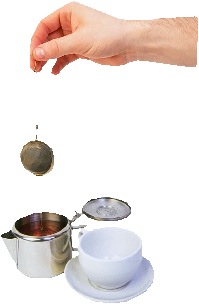
-
If you are just making one cup, put leaves in a teaball and into cup
-
Do not pack strainers or teaballs too tightly--or most of the leaves will never get wet--make sure your strainer is big enough for the amount of tea you are making
When water has boiled, take it off the heat for 10 second and then pour it over the strainer--and let steep for 3-5 minutes depending on your taste. Remove strainer and serve plain or with honey, demmerara sugar, cream or lemon.
ICED TEA ~ Make the same as for social teas--BUT--add a few more teaspoons of herb to make up for the dilution of the ice. Refrigerate after steeping and then add ice to the cup at serving time
A MEDICINAL tea is made a bit differently~
While social teas are steeped for a short time and are meant to be mild flavored, they still offer plenty of medicinal attributes-especially if taken daily for purposes of health maintainence and prevention. Teas meant for healing of aggressive or chronic illnesses, though, need to be stronger and are therefore steeped for HOURS rather than minutes, allowing for deeper constituents, such as alkoloids and glycosides, among many others, to be released.( Another form of medicinal tea is called a "Decoction"--which sometimes involves the use of barks and roots that need to be boiled -or used as a base for syrups. ) Along with the added medicinal strength also comes stronger and sometimes overwhelming flavors. Mild a fruity chamomile becomes horribly bitter after just 10 minutes of steeping (as do most teas made of a plant's flowers) but luckily, a five minute steep of chamomile, lavender or even mint is enough ot relieve normal stress and mild headaches. What to do? I am not one who believes that for something to be good for you-it has to taste bad. I have found that just about any medicinal tea (except Chapparel, Goldenseal, Valerian or Yellow Dock) can be made flavorful enough by adding Mint--any kind of mint you like and as much as you need. Aside from the good and familiar taste, mints offer their own healing properties, most notably-digestive and nervous system tonification, that will allow the other herbs in your tea to actually work better. So, keep this tip in mind-especially when making a tea for skeptics or children. * NOTE- Some teas need to be made with a COLD INFUSION-which is to say, steeping in cool/room temperature water. Herbs such as mallow root,comfrey root, licorice, slippery elm and cinnamon powder should be made this way as it maintains their medicinal power and makes them taste better.
-
Unlike social teas, medicinal teas need to be taken in larger amounts (1-3 cups per day)-so it is easier to make it all at once
-
Place 3-4 full Tsp. of dry herb or 6-8 Tsp. of fresh plant material in a quart canning jar. Boil 3-4 cups water water, THEN pour over plants. Put jar lid on immediately and then let set 4-8 hours. Drink at room temperature all day long (**Note- only canning jars or gallon pickle jars can be used as other types may crack when in contact with boiling water).
-
Do not refrigerate and only make enough for 1 day. Make fresh daily.
-
Continue drinking a medicinal tea 1 week past the time you feel better--its purpose is not just to "cure" a particular illness, but also to strenghthen the involved and other body systems.
-
Children under 12 only need from 1/4 cup to 1 cup per day--(you may also dilute their tea in water or juice).
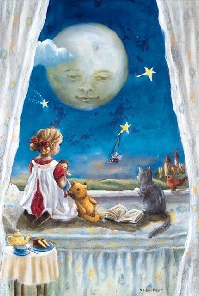
-
Kids should also have their own "special" tea cups that are used only when they are sick ~ being pampered is a really magical type of healing!
-
For convenience, it is easiest to make your tea at night, let it steep overnight, strain and then put it in a thermos for work or simply sip it all day
-
REMEMBER THE MINT!!!
-
Sugar, sweeteners or milk are rarely added to Medicinal or Tonic teas unless HONEY is added for its own qualities in the treatment of sore throats or lung conditions.
-
A smidge of cayenne or oregano can be added to ANY type of tea to help fight off sore throats/colds/flu
-
Tea isn't over until it's over!! You can put all the left over teabags or teapot dregs to good use- flowers love it, add to your compost, put them in a garni bag and wash your tired/smelly feet or lay on your tired eyes for refreshment, rinse your hair with them or even dye material to give it an antique look.
TONIC TEA ~
Tonic teas are for those who are either dealing with a long term, chronic condition-or are predisposed to one. In that case, Prepare your tea as for the Medicinal Tea, but only take 1 cup per day. Take indefinitely. (**Note- those taking medicinal teas long term should be doing so with medical or an herbalist's guidance).
**Always let tea (or any hot drink) cool for several minutes before drinking!! Burning the tender tissues of the mouth/tongue can lead to cell damage**
WHAT YOU NEED FOR TEA ~
It is fairly simple-aside from the good water and herbs, you just need a few pieces of equipment: Teapot made of glass, earthenware or porcelin, quart canning jars/lids, several gallon jars for making Sun Tea (and some food grade cheesecloth which can be used for straining large quantities of fresh herbs), strainers and an enamel or stainless steel tea kettle. All the other things are optional, but fun to have-such as: different size teapots to serve yourself or larger for different seasonal occasions, various sizes of strainers, teabags for days when you are too lazy to measure out tea or when you travel. I love the idea of bamboo strainers, but to be honest, they mold and are not tightly woven enough to keep all stray bits of tea leaves out of your cup. Tea balls come in a lot of sizes. I have one to fit a child's cup and one that holds almost 2 cups of leaves for a gallon jug. A really handy thing is a French Coffee Press, which can be used instead of a quart jar and strainer. I have a tea service that was a wedding gift to my grandparents, I have sugar cube tongs, I have mismatched plates/cups and spoons, several tea pots, and also have an antique teacup collection which get used for special occasions with family and friends, a big basket full of cloth napkins, a triple tiered serving tray--all hardly ever used. Everyday, my reliable copper clad English tea kettle, my Ball canning jar, my mug, and a strainer are my mainstays.
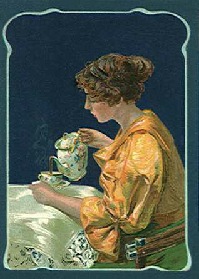 It is a ritual, really ~ putting on the kettle, choosing a tea, deciding what to eat with it, then, depending on the day, finding something to read, or a quiet place to sit on the porch or beside the woodstove or a special area of the garden where something new is blooming ~ and knowing that with rare exception, no matter how my day goes, I will have that oasis of calm.
It is a ritual, really ~ putting on the kettle, choosing a tea, deciding what to eat with it, then, depending on the day, finding something to read, or a quiet place to sit on the porch or beside the woodstove or a special area of the garden where something new is blooming ~ and knowing that with rare exception, no matter how my day goes, I will have that oasis of calm.
"One sip of this will bathe the drooping spirits in delight, beyond the bliss of dreams." ~ Milton
~ HERBAL TEA PARTIES ~ (*AVAILABLE SOON !)
There are a lot of great books that outline formal tea theme parties, but here, I want to stick to making practical, healthy teas.... fun! A daily tea, to me, is a must, but parties can be a regular occurance too--as long as they are low stress.
An Herbal Tea Party can be adapted for as many participants as you wish, and the basic format will always include a particular pairing of herb teas and hearty herbal meals along with a matching topical or seasonal theme. The teas can be worked into an existing regular meeting or club you already attend or you can start a new get together trend ~
EACH TEA PARTY WILL INCLUDE ~
-
Topical or Seasonal Theme & Introduction
-
Herb Tea- with information on its healing qualities, lore and how to prepare it
-
Herbal Menu- which includes recipes for appetizers, entree, side dishes, dessert(*All foods are ovo-lacto vegetarian) & information about the medicinal qualities of each food and herb
-
Suggestions and Directions for Party Decor
-
Party Format
-
Activities and or Projects with complete directions
-
Supplies List/Resource Guide
-
Suggested Reading
-
Links to Related Sites
*Herbal Tea Parties may be purchases individually or a year's worth (12 parties) for the price of 10 ~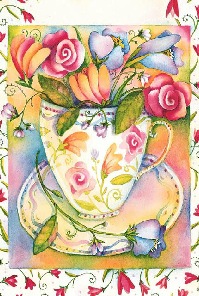 (*Parties are $5 each)
(*Parties are $5 each)
MONTHLY TEA PARTIES ~ For Adults
-
January ~ DREAMTIME TEA
-
February ~ APHRODI-TEA
-
March ~ HEIRLOOM TEA
-
April ~ FOOL'S TEA
-
May ~ GARDENING TEA
-
June ~ SERENDIPI-TEA
-
July ~ LIBER-TEA
-
August ~ HERBALIST'S TEA ~ Walk on the Wild Side!
-
September ~ HERBAL LITERARY TEA
-
October ~ MAGICAL FULL MOON TEA
-
November ~ CRAFT- TEA
-
December ~ BEAU-TEA ~ Facials/Footbaths and Tea
SEASONAL TEAS ~
-
Fall ~ HARVEST & REMEMBERANCE TEA
-
Winter ~ SOLSTICE ~LIGHT IN THE NIGHT TEA
-
Spring ~ SPRING FEVER TEA
-
Summer ~ NATURE'S BOUN-TEA
*Classes Available Soon! *New Themes Added Periodically
CHILDREN'S TEA PARTIES ~
Sometimes kids don't like "real" tea, but there are several ways around that. Among them, is the "Cambric" tea-which puts very little tea in the cup, but lots of milk and 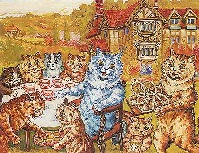 honey ~ or ~ Jam tea. The main thing is for the Themes to be fun and meaningful. These Tea Parties are full of activities and easy to prepare (often by the kids themselves) healthy, herbal foods.
honey ~ or ~ Jam tea. The main thing is for the Themes to be fun and meaningful. These Tea Parties are full of activities and easy to prepare (often by the kids themselves) healthy, herbal foods.
"You are going out for tea today, so mind how you behave; Let all accounts I hear of you be pleasant ones, I crave."
~ Kate Greenway
-
January ~ DRAMA TEA
-
February ~ SNOW DAY TEA
-
March ~ MAD HATTER'S TEA
-
April ~ SPRING HAS SPRUNG TEA
-
May ~ MAY DAY TEA
-
June ~ MIDSUMMER'S FAERIE TEA
-
July ~ LAMB'S EARS IN THE GARDEN ~ WILD CHILD TEA
-
August ~ PET'S TEA
-
September ~ CHILDREN'S HERBAL LITERATURE TEA
-
October ~ ALL HALLOW'S MAGICAL TEA
-
November ~ GIVING THANKS TEA
-
December ~ MOON & STARS TEA
"I'm a little teapot, short and stout; here's my handle, here's my spout; When it's time to pour me, I begin to shout; Tip me up and pour me out!"
~ Nursery Rhyme
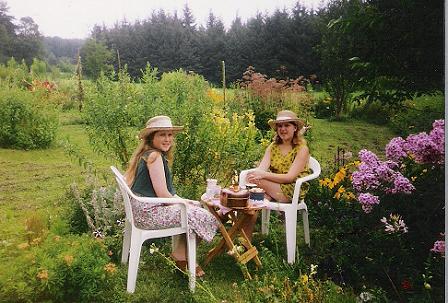
"Tea's proper use is to amuse the idle, relax the studious, and dilute the full meals of those who cannot use exercise, and will not use abstinence." ~ Samuel Johnson
Aside from actually eating healthy foods and herbs, taking your nutrients and medicines in the form teas is the most healing. Well or ill, a daily tea soothes body, mind, spirit and is a ritual that can order an otherwise chaotic day. As a way to introduce yourself to herbs or as a means of taking responsibility for your general wellbeing, there is no way superior than...TEA
"The path to heaven passes through a teapot" ~ Ancient proverb
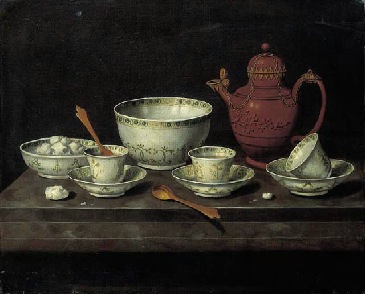
*Read more about herbal teas and their particular healing capabilities which are covered extensively on other pages of this website and in the Herbal Classes offered herein.